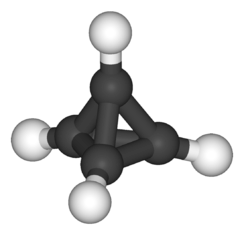Platonic hydrocarbon
A Platonic hydrocarbon is a hydrocarbon (molecule) whose structure matches one of the five Platonic solids, with carbon atoms replacing its vertices, carbon–carbon bonds replacing its edges, and hydrogen atoms as needed.[1]
Not all Platonic solids have molecular hydrocarbon counterparts.
Tetrahedrane
Tetrahedrane (C4H4) is a hypothetical compound. It has not yet been synthesized without substituents, but it is predicted to be kinetically stable in spite of its acute bond angle and angle strain. Some stable derivatives, including tetra-tert-butyltetrahedrane (a hydrocarbon) and tetra(trimethylsilyl)tetrahedrane, have been produced.
Cubane
Cubane (C8H8) has been synthesized.
Octahedrane
Angle strain prevents formation of an octahedron,[2] and since 4 edges meet at each corner, there would be no hydrogen atoms; thus, the hypothetical octahedrane molecule would be an allotrope of elemental carbon, C6, and not a hydrocarbon. The existence of octahedrane cannot be ruled out completely, although calculations have shown that it is unlikely.[3]
Icosahedrane
The tetravalency (4-connectedness) of carbon excludes an icosahedron since 5 edges meet at each vertex; pentacoordinate carbon, such as CH5+, is unlikely, although both icosahedrane and octahedrane have been observed in boron compounds.[3]
Dodecahedrane
Dodecahedrane (C20H20) has been synthesized.
Other polyhedra
With increasing numbers of carbon atoms in the frame, the geometry more closely approximates a sphere, and the space enclosed in the carbon "cage" increases. This trend continues with buckyballs or spherical fullerene (C60). Although not a Platonic hydrocarbon, fullerene has the shape of a truncated icosahedron, an Archimedean solid.
References
- ↑ Henning Hopf, Classics in Hydrocarbon Chemistry, Wiley VCH, 2000.
- ↑ Nevertheless, note the existence of [1.1.1.1]paddlane C(CH2)4C, CAS number 102843-69-6 and the theoretical existence of pyramidane which is a half octahedron with one carbon on a vertex just like those appearing in the octahedron.
- ↑ 3.0 3.1 Lewars, Errol G. (2008). Modeling Marvels: Computational Anticipation of Novel molecules. Springer Science+Business Media. pp. 81–82. doi:10.1007/978-1-4020-6973-4. ISBN 978-1-4020-6972-7. Retrieved January 30, 2012.
| Wikimedia Commons has media related to Platonic hydrocarbons. |


